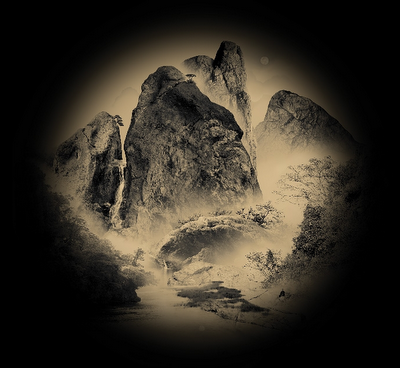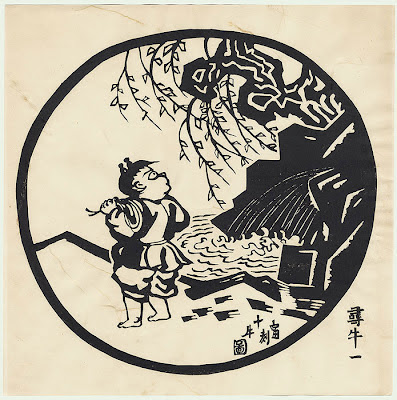Bujinkan Hachidan 八段: Both Bull and Self Transcended
From Bujinkan Santa Monica by Michael
 |
| Both Ox and Self Transcended, digital c-print photograph by Andrew Binkley |
If you haven't read my other posts in this series, please check them out. You may find them useful no matter what your rank is:
Bujinkan Shodan 初段: Searching for the BullSo what kind of training do we do for Hachidan?
Bujinkan Nidan 弐段: Discovering the Footprints
Bujinkan Sandan 参段: Perceiving the Bull
Bujinkan Yondan 四段: Catching the Bull
Bujinkan Godan 五段: Taming the Bull
Bujinkan Rokudan 六段: Riding the Bull Home
Bujinkan Nanadan 七段: The Bull Transcended
 |
| Woodblock print by 德力富吉郎 Tokuriki Tomikichirō |
Whip, rope, person, and bull -
all merge in No Thing.
This heaven is so vast,
no message can stain it.
How may a snowflake exist
in a raging fire?
Here are the footprints of
the Ancestors.
I have abandoned the whip and ropes
At this stage of our training we have reached the state of zero Hatsumi Sensei often speaks about. In the dojo we neither train nor not train. We neither attack nor not attack. We neither defend nor not defend.
By being in neither position we become invisible. This is an aspect of ninjutsu and disappearing in plain sight. It is difficult for students because they will never see what the teacher is doing or not doing. Teachers cannot really explain it to students because they neither teach nor not teach.
In the original oxherding pictures from India and China, this was the last stage. Kakuan fleshed these ideas out from his 12th century Zen perspective so that the emptiness of the circle would not be the final goal of zen. But what is the quality of this emptiness in our training?
We can borrow a Buddhist phrase and parody it here: We do not linger where there is technique and we pass quickly through where there is no technique. Stopping to admire technique or no technique is the same trap as being tied to the Ox or the self.
We become a person who is nowhere. Hatsumi Sensei describes this in what it means to be Soke:
"Soke" signifies nothingness, zero, emptiness, void. Something that exists, and yet does not. The Soke is just an ordinary person, and yet, somehow, he is someone who is living his life according to some invisible divine command. You see, I do not live by my conscious mind, not at all, so that whatever I have thought up till now can just suddenly change in my mind, though it is not a consciously engineered change."And here is the same idea from Zen:
"A distinguished Zen teacher, questioned as to how he disciplined himself in the truth, simply said: 'When I am hungry I eat; when tired I sleep.' The questioner remarked that this was what everybody did and asked whether they could be considered as practising the discipline as he did. The teacher replied: 'No; because when they eat they do not eat, but are thinking of various other things thereby allowing themselves to be disturbed; when they sleep they do not sleep, but dream of a thousand and one things. This is why they are not like myself."The emptiness of this stage burns away every thought of technique or no technique. It burns away any thought of attacker or no attacker. Defender or no defender. As the poem above states, dualistic and discriminating thoughts are burned away like a snowflake in a raging fire…
This is at the heart of 万変不驚 Banpen Fugyo, as Hatsumi Sensei describes, "It's where you're not expecting anything, but you're ready for anything. You're all potential."
At this stage we are connected to our ancestors and the Bujin.
From this place we will explore Bujinkan Kyūdan 九段: Reaching the Source















